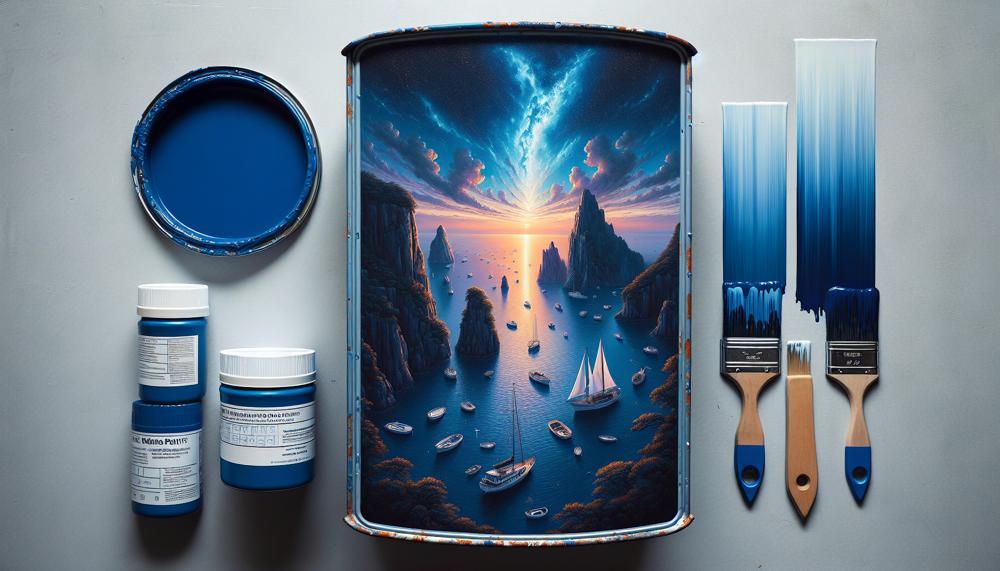Are you tired of stepping into a dull, old bathtub every day? Are you looking for an affordable way to give your bathroom a fresh new look? Well, look no further because we have the perfect solution – marine paint. Yes, you heard that right—marine paint is not just for boats anymore.
In fact, it can be used on bathtubs to create a stunning and long-lasting finish.
In this guide, let us convince you with these key points:
- Marine paint is specifically formulated to withstand harsh conditions such as water, salt, and sun exposure. This makes it the perfect choice for bathtubs that are constantly exposed to water and cleaning products.
- With a wide range of colors and finishes available, you can easily customize the look of your bathtub to match your bathroom décor.
- Not only is marine paint aesthetically pleasing, but it is also highly durable and resistant to chipping, peeling, and fading. This means your newly painted bathtub will maintain its shine and color for years to come.
- Applying marine paint is a breeze – simply clean the surface, lightly sand it down, apply a primer if necessary, and then get painting.
- And the benefits don’t stop there – marine paint also helps protect your bathtub from rust and corrosion.
Why spend a fortune on a new bathtub when you can give your current one a stunning makeover with marine paint? Say goodbye to plain white tubs and hello to a vibrant and long-lasting addition to your bathroom.
So, go ahead and dive into this budget-friendly DIY project today.
Contents
- 1 Can You Use Marine Paint On A Bathtub?
- 2 The Differences Between Marine Paint and Regular Paint
- 3 The Benefits of Using Marine Paint on Boats
- 4 Can You Use Marine Paint on a Bathtub?
- 5 Preparing the Bathtub Surface for Marine Paint
- 6 Potential Health Hazards of Using Marine Paint in a Bathroom
- 7 Long-Term Durability and Maintenance Considerations
- 8 Conclusion
Can You Use Marine Paint On A Bathtub?
Before you decide to use marine paint on a bathtub, there are several factors that you must take into consideration. These include the material of the tub, its current condition, the type of marine paint being used, the preparation and application process, potential health hazards, and long-term durability and maintenance.
Firstly, it is essential to determine the type of material your bathtub is made of. Different materials may react differently with marine paint, and using the wrong type can result in a poor finish or damage to the surface. Therefore, thorough research on compatibility is crucial before proceeding with the project.
Next, consider the current condition of the bathtub. If there are any cracks or chips on the surface, marine paint may not provide a smooth and even finish. In such cases, it is recommended to repair these imperfections before applying marine paint for the best results.
When choosing a marine paint, there are various options available, each with its own unique properties and uses. It is crucial to select the right type for your specific project to ensure optimal results.
Proper preparation and application techniques are also crucial to achieving a successful outcome when using marine paint on a bathtub. The surface must be properly cleaned and primed before applying the paint, and following the recommended application process can greatly affect its durability.
It is also important to note that marine paint contains high levels of VOCs, which can be harmful if inhaled excessively.
| Factors to Consider Before Applying Marine Paint on a Bathtub | Details to Keep in Mind |
|---|---|
| Bathtub’s Material | Different materials may react differently with marine paint, so it is crucial to research compatibility beforehand. |
| Bathtub’s Condition | If the surface has cracks or chips, marine paint may not provide a smooth and even finish. |
| Marine Paint Type | There are several types of marine paint available, each with unique properties and uses. Selecting the right type for your specific project is essential. |
| Preparation and Application Process | Properly preparing the surface and following recommended application techniques can significantly impact the outcome and durability of using marine paint on a bathtub. |
| Potential Health Hazards | Marine paint contains high levels of VOCs, which can be harmful if inhaled excessively. Taking proper safety precautions when using it in an enclosed space like a bathroom is crucial. |
| Long-Term Durability and Maintenance | Regular exposure to water and chemicals may cause marine paint to deteriorate over time, requiring frequent touch-ups or reapplication. |
The Differences Between Marine Paint and Regular Paint
The core distinctions between marine paint and regular paint, which determine their suitability for use on bathtubs, are their composition, longevity, and ability to endure harsh environments.
Marine paint contains specialized components, such as epoxy resins, that create a formidable barrier against water, making it the perfect option for bathtubs that are constantly exposed to moisture.
Moreover, it is highly resilient and can withstand UV rays, moisture, and saltwater, making it a superior choice for both protection and aesthetic enhancement of bathtubs.
In contrast, regular paint is not designed to endure extreme conditions and is prone to chipping or cracking when applied to bathtubs, resulting in costly repairs.
As someone who has had to deal with the consequences of using regular paint on a bathtub, I can attest to the difference that marine paint makes. A few years ago, I decided to renovate my bathroom and thought I could save some money by using regular paint on the bathtub instead of investing in marine paint.
However, within a few months, I noticed that the paint was starting to peel and crack due to the constant exposure to water. Not only did this ruin the appearance of my bathtub, but it also led to expensive repairs as I had to completely strip off the old paint and reapply marine paint.
This experience taught me the importance of using the right type of paint for different surfaces. While regular paint may be suitable for walls and furniture, it is not meant for surfaces that are constantly exposed to moisture and harsh conditions, like bathtubs.
Investing in marine paint may seem like a higher upfront cost, but in the long run, it will save you both time and money by providing long-lasting protection and beauty for your bathtub.
The Benefits of Using Marine Paint on Boats
Marine paint is a remarkable option for enhancing the durability and appearance of bathtubs. Its unique properties make it highly resistant to water damage, chipping, cracking, and fading.
With its strong adhesion and resilience to wear and tear, marine paint can significantly extend the lifespan of a bathtub, saving homeowners from costly repairs or replacements.
Not only that, but marine paint also offers a wide range of colors and finishes, providing endless possibilities for customization and creativity in home improvement projects. Its glossy finish adds a touch of elegance to any bathtub, giving it a sleek and polished look.
Moreover, marine paint can effectively cover up any imperfections or stains on an old bathtub, giving it a fresh and new appearance without the need for expensive replacements or renovations.
Apart from durability and appearance, marine paint also has other benefits when used on bathtubs. It provides a non-slip surface, making it safer for bathing, especially for households with children or elderly individuals.
Additionally, its water-resistant properties make cleaning and maintenance easier, as it can withstand frequent exposure to water and cleaning products without losing its color or finish.
Can You Use Marine Paint on a Bathtub?
It is generally considered safe to use marine paint on a bathtub for a do-it-yourself home improvement project. However, there are several important factors to keep in mind and precautions to take in order to achieve the best results and ensure safety.
Using Marine Paint on a Bathtub:
Marine paint can be applied to bathtubs made of various materials, such as porcelain, fiberglass, and acrylic. It provides a strong and durable coating that can withstand daily wear and tear in a high-moisture environment.
However, proper surface preparation is crucial for achieving proper adhesion and durability.
Preparation:
Before painting, it is essential to thoroughly clean the bathtub with a mild detergent or cleaner to remove any dirt, oil, or residue. Rinse well and allow the tub to dry completely.
Next, sand the surface with fine-grit sandpaper to create a rough texture for the paint to adhere to. Wipe away any dust or debris from sanding before proceeding.
Priming:
It is highly recommended to prime the bathtub before applying marine paint. This will aid in better adhesion and prevent potential discoloration or peeling in the future. Use a primer specially designed for bathtubs, and follow the manufacturer’s instructions for application.
Painting:
Choose a high-quality marine paint specifically formulated for surfaces exposed to water and moisture. Apply multiple thin coats instead of one thick coat for better coverage and durability. Allow each coat to dry completely before applying the next one.
Safety Precautions:
When working with marine paint, it is important to take the necessary safety precautions. Wear protective gear such as gloves, goggles, and a mask to avoid direct contact with the paint and harmful fumes. Ensure proper ventilation in the area where you are painting.
Preparing the Bathtub Surface for Marine Paint
To achieve a pristine and enduring finish, it is imperative to properly prepare the bathtub surface before applying marine paint. This process entails meticulous cleaning, sanding, and priming for optimal adhesion and durability.
Firstly, the surface must be thoroughly cleansed of any dirt, grime, or residue that may hinder the paint’s ability to adhere. This step is crucial to ensuring a smooth and even application of the marine paint. One must take care to use appropriate cleaning agents that are gentle yet effective, as harsh chemicals can damage the surface and compromise the paint’s adhesion.
Next, sanding is essential to creating a rough texture on the surface that allows the paint to grip firmly. This also helps to remove any imperfections or previous layers of paint that may cause the new layer to peel or bubble over time. With precision and care, one must sand the entire surface using fine-grit sandpaper until a uniform texture is achieved.
After sanding, the surface should be primed with a high-quality marine primer. This serves as a bonding agent between the surface and the paint, ensuring a lasting finish. It also helps to seal any remaining imperfections on the surface, providing a smooth base for the paint to adhere to.
Proper preparation of the bathtub surface is crucial to achieving a durable and flawless finish with marine paint. Taking the time and care to clean, sand, and prime the surface will result in a professional-looking outcome that will withstand the test of time.
Potential Health Hazards of Using Marine Paint in a Bathroom
When it comes to DIY home projects, many people turn to marine paint as their go-to option. However, before using it in a bathroom, it’s crucial to understand the potential health hazards it may bring.
Marine paint is packed with volatile organic compounds (VOCs), which can be harmful if inhaled or ingested.
These compounds are emitted into the air during and after application of the paint, and can result in respiratory issues, headaches, dizziness, and nausea.
Besides VOCs, marine paint also contains toxic chemicals like formaldehyde, isocyanates, and heavy metals such as lead and mercury. These substances can cause skin irritation, allergic reactions, and even long-term health problems like cancer.
In a small and enclosed space like a bathroom, these chemicals can have a more concentrated and damaging impact on individuals.
Moreover, marine paint can also contribute to poor indoor air quality. The high levels of VOCs released during application and curing process can linger in the air for days or even weeks, causing unpleasant odors and potentially triggering allergies or respiratory conditions.
While marine paint is known for its durability and water resistance, it’s important to carefully consider its potential health hazards before using it in a bathroom.
If you do choose to use marine paint in this setting, make sure to take necessary precautions, such as wearing protective gear, ensuring proper ventilation, and avoiding direct contact with the paint. It’s also recommended to opt for low-VOC or zero-VOC marine paints for a safer and healthier alternative.
So, while marine paint may seem like a convenient option for bathroom projects, it’s crucial to prioritize your health and well-being by being aware of its potential hazards.
Long-Term Durability and Maintenance Considerations
When it comes to ensuring long-term durability and maintenance for your bathtub, there are several crucial factors to keep in mind. Proper preparation, the type of marine paint used, the environment in which it is applied, application techniques, and ongoing maintenance all play a vital role in achieving the best results.

First and foremost, proper preparation is key. Before applying marine paint to your bathtub, it is essential to thoroughly clean and sand the surface to remove any dirt, grime, or previous coatings. This will ensure that the paint properly adheres and creates a strong bond for maximum durability.
Next, choosing the right type of marine paint is crucial. There are various options available on the market, each with its own unique qualities and benefits. It is important to research and select a paint that is specifically designed for use on bathtubs and can withstand constant exposure to water.
The environment in which the marine paint is applied also plays a significant role in its effectiveness. Factors such as temperature, humidity levels, and ventilation can all impact the application process and final results. It is important to follow manufacturer guidelines and choose a suitable location for painting your bathtub.
Application techniques are also essential to consider for optimal results. Properly applying multiple thin coats of paint will provide better coverage and a smoother finish compared to one thick coat.
Additionally, using a high-quality brush or roller can make a significant difference in achieving a professional-looking result.
Finally, ongoing maintenance is crucial for long-term durability. Regular cleaning and touch-ups as needed will help maintain the integrity of the paint and extend its lifespan. It is also essential to address any issues or damage promptly to prevent further deterioration.
Conclusion
In conclusion, marine paint is a game-changer for anyone looking to revamp their bathtub.
With its wide range of colors and finishes, this specialized paint is designed to withstand tough conditions such as water, salt, and sun exposure.
Its durability and resistance to chipping, peeling, and fading make it the perfect choice for bathtubs that are constantly exposed to moisture and cleaning products.
Say goodbye to boring white tubs and welcome a vibrant, customized addition to your home with marine paint.






